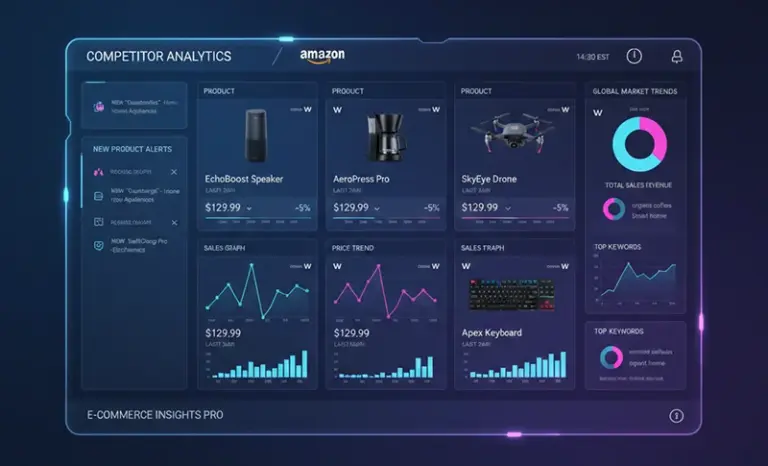3 AM. The phone vibrates. Mark opens his bleary eyes to see an alert from his Amazon store data monitoring system: his main competitor just launched a new product, priced 15% lower than his bestseller, and already running sponsored ads. This wasn’t the first time. Over the past three months, he’d watched helplessly as market share in two core categories got eaten away—all because his reliance on manual checks left him without real-time Amazon store data monitoring capabilities, leaving him perpetually one step behind his rivals.
In Amazon’s rapidly changing battlefield, information gap equals the line between life and death. While you’re still manually refreshing competitor pages, top sellers have already built minute-level automated monitoring systems. They receive notifications the moment competitors adjust prices, precisely capture the golden window when new products launch, and even reverse-engineer rivals’ advertising strategies through sales fluctuations. This capability gap directly determines who breaks through in red ocean markets.
Why Competitor Monitoring Became an Operational Necessity
E-commerce operations are essentially an information war. Amazon sees millions of daily price adjustments and hundreds of thousands of new product launches, with competitors potentially scattered across global time zones. Relying on manual monitoring isn’t just inefficient—more critically, it causes you to miss crucial decision windows. Imagine this scenario: a competitor suddenly slashes prices to clear inventory; by the time you notice the next day, they’ve already captured massive orders and boosted their BSR ranking. Or rivals test a new product, validate market fit, and scale rapidly, while you only spot the trend three weeks later when market dynamics have already formed.
The deeper reason is that Amazon store data monitoring isn’t merely passive defense—it’s an intelligence source for active offense. Through systematic tracking of competitor operations, you can decode their product selection logic, pricing strategies, inventory turnover rhythm, and even advertising ROI models. These insights transform into your own competitive advantages—knowing when to follow, when to differentiate, when to launch price wars.
From practical application scenarios, competitor store tracking tools deliver value across multiple dimensions. New product monitoring helps identify market trends and potential bestsellers, avoiding blind following while discovering innovation opportunities. Price monitoring forms the foundation of maintaining competitiveness, especially in Buy Box battles where real-time price intelligence directly impacts conversion rates. Sales change analysis represents strategic-level data, revealing competitors’ true market performance beyond surface-level review counts and star ratings.
Core Methodology for Building Competitor Monitoring Systems
Establishing an effective monitoring system requires first clarifying selection criteria for monitoring targets. Not all competitors deserve tracking effort. Highest priority goes to sellers with over 60% category overlap, similar price ranges, and monthly sales between 1.5x and 0.5x of yours—these are true direct competitors. Next come category leaders whose moves often represent industry trends. Finally, new entrants showing abnormal performance may hide novel strategies.
Monitoring indicator setup needs layered design. The foundation layer tracks changes in basic product information: title optimization, main image replacement, A+ content adjustments—these seemingly minor changes often signal operational strategy shifts. The middle layer covers dynamic data: price fluctuation amplitude and frequency, inventory level changes, variant SKU additions and deletions. The advanced layer includes derivative indicators: reverse-calculating daily sales from BSR ranking changes, estimating ad budgets from sponsored position appearance frequency, judging review manipulation from review growth speed.
For technical implementation paths, three main approaches each have pros and cons. First is using third-party SaaS tools—advantages include out-of-box usability and friendly interfaces, while disadvantages involve limited monitoring dimensions, fixed data update frequencies, and costs scaling linearly with monitored ASIN count. Second is building in-house crawler teams, offering maximum flexibility but requiring continuous development resources and dealing with Amazon’s anti-scraping mechanism upgrades. Third is adopting professional seller store data collection API services, balancing flexibility and cost, particularly suitable for teams with some technical capability but unwilling to maintain crawler infrastructure.
Real-World Practice: Complete Chain from Data Collection to Intelligent Alerts
Let’s dissect the entire monitoring workflow through a real case. Suppose you operate in the kitchen category on the US marketplace, needing to monitor approximately 500 ASINs across 20 main competitor stores. Traditional approaches might assign operations staff to manual daily checks, but this method is not only time-consuming—more importantly, it cannot capture changes during non-working hours.
The first step in an automated solution is establishing the data collection layer. The key here is selecting appropriate data sources and collection frequencies. For price-sensitive products, hourly collection might be necessary; for new product monitoring, 2-3 times daily suffices. The collected data structure should include timestamps, ASINs, prices, stock status, BSR rankings, review counts, ratings, variation information, and other core fields.
Here’s a code example implementing this via API (using Python):
import requests
import json
from datetime import datetime
class CompetitorMonitor:
def __init__(self, api_key):
self.api_key = api_key
self.base_url = "https://api.pangolinfo.com/scrape"
def fetch_product_data(self, asin, marketplace='US'):
"""Fetch real-time data for a single ASIN"""
params = {
'api_key': self.api_key,
'asin': asin,
'marketplace': marketplace,
'data_type': 'product_detail'
}
response = requests.get(self.base_url, params=params)
if response.status_code == 200:
data = response.json()
return self.parse_product_info(data)
return None
def parse_product_info(self, raw_data):
"""Parse key monitoring metrics"""
return {
'timestamp': datetime.now().isoformat(),
'asin': raw_data.get('asin'),
'title': raw_data.get('title'),
'price': raw_data.get('price', {}).get('value'),
'currency': raw_data.get('price', {}).get('currency'),
'availability': raw_data.get('availability'),
'bsr_rank': raw_data.get('bestsellers_rank', [{}])[0].get('rank'),
'rating': raw_data.get('rating'),
'review_count': raw_data.get('reviews_total'),
'variations_count': len(raw_data.get('variations', []))
}
def monitor_store(self, seller_id, check_interval=3600):
"""Monitor all products in an entire store"""
# First get all ASIN list for the store
store_asins = self.get_seller_products(seller_id)
results = []
for asin in store_asins:
product_data = self.fetch_product_data(asin)
if product_data:
results.append(product_data)
# Detect anomalous changes
self.check_alerts(product_data)
return results
def check_alerts(self, current_data):
"""Intelligent alert logic"""
# Retrieve historical data from database for comparison
historical = self.get_historical_data(current_data['asin'])
if not historical:
return
# Price change exceeds 10%
if abs(current_data['price'] - historical['price']) / historical['price'] > 0.1:
self.send_alert(f"Price anomaly: {current_data['asin']}
changed from ${historical['price']} to ${current_data['price']}")
# New variations added
if current_data['variations_count'] > historical['variations_count']:
self.send_alert(f"New variations: {current_data['asin']}
variation count increased from {historical['variations_count']}
to {current_data['variations_count']}")
# Significant BSR ranking improvement (numerical decrease)
if historical['bsr_rank'] and current_data['bsr_rank']:
if (historical['bsr_rank'] - current_data['bsr_rank']) / historical['bsr_rank'] > 0.3:
self.send_alert(f"Ranking surge: {current_data['asin']}
BSR improved from {historical['bsr_rank']}
to {current_data['bsr_rank']}")
This code demonstrates the core logic framework of a monitoring system. Real-world applications also require database storage for historical records, message queues for asynchronous task processing, and visualization dashboards for displaying monitoring results. The key is establishing a closed-loop mechanism of “collection-storage-comparison-alerting.”
After data collection, more important is data analysis and application. Mere data accumulation has no value—it must transform into executable operational decisions. For instance, discovering competitors frequently adjust prices during certain time periods might mean they’re testing optimal price points. If multiple competitors simultaneously launch similar new products, it indicates new ODM solutions emerging from upstream supply chains. When a competitor’s ad position appearance frequency suddenly drops but sales don’t noticeably fluctuate, they may have found more efficient traffic channels.
Advanced Strategies: From Passive Monitoring to Active Intelligence Mining
True masters don’t stop at monitoring surface data. They build deeper analytical models. For example, by long-term tracking of competitor inventory change cycles, you can reverse-engineer their stocking strategies and capital turnover capabilities—if a seller always restocks heavily at month-start and clears inventory at month-end, it suggests potentially tight cash flow, presenting a good opportunity to launch price wars.
Another dimension is advertising intelligence acquisition. While Amazon doesn’t publicly share competitor ad data, high-frequency collection of sponsored positions on search result pages can statistically reveal which keywords competitors target, what positions they appear in, and how their placement schedules distribute. This information holds tremendous reference value for optimizing your own advertising strategies. Especially for professional tools achieving 98% sponsored ad collection rates, they can almost completely reconstruct competitors’ advertising placement maps.
Another advanced application of store dynamic analysis is identifying operational team capability boundaries. If a seller consistently succeeds in one category but performs mediocrely entering new categories, their advantages may stem more from supply chains than operational capabilities. Conversely, if they can create bestsellers across multiple unrelated categories, such sellers deserve deep study of their product selection methodology and operational SOPs.
Tool Selection: Finding Balance Between Efficiency and Cost
The market offers diverse competitor monitoring tools, from free browser extensions to enterprise-level SaaS platforms. Selection requires considering several core dimensions: whether data update frequency meets your decision-making rhythm, whether monitored ASIN quantity has limits, how data accuracy and completeness measure up, whether custom alert rules are supported, and most importantly—whether the cost structure is reasonable.
For starting small and medium sellers, begin with lightweight solutions. Browser extensions combined with manual recording, though primitive, build monitoring awareness. When monitoring needs grow to dozens of ASINs, consider cost-effective SaaS tools. But if your business scale reaches needing to monitor hundreds or even thousands of ASINs, requiring minute-level updates and personalized analysis dimensions, building your own monitoring system based on APIs becomes inevitable.
API solutions’ advantages lie in flexibility and scalability. You can customize collection frequencies according to your business logic—implementing hourly monitoring for core competitors while collecting once daily for secondary targets. This differentiated strategy significantly reduces costs. Meanwhile, raw data returned by APIs can seamlessly integrate with your existing ERP systems and BI platforms, achieving full-process automation from data collection to decision execution.
Particularly worth mentioning, professional rival new product monitoring must not only capture new ASINs but also identify major changes to existing ASINs—such as complete main image replacements, total title rewrites, price range leaps—these often mean sellers are repositioning products. Traditional tools might only record data changes without understanding the operational intent behind them.
No-Code Solutions: Empowering Non-Technical Teams to Master Monitoring
Not all sellers have technical team support. For this user segment, no-code configuration tools like AMZ Data Tracker offer another possibility. Through visual interfaces, operations personnel can directly add ASINs or store IDs needing monitoring, set collection frequencies and alert thresholds, and the system automatically completes data scraping and anomaly notifications.
These tools’ core value lies in lowering usage barriers. You don’t need to understand API calls, write code, or set up servers—just configure rules as simply as using Excel. Minute-level scheduled collection ensures data timeliness, while anomaly alert functions promptly notify key changes via email or message push. For precise ASIN full data extraction needs, these tools typically have built-in mature parsing templates covering various data fields on product detail pages.
Of course, no-code solutions have limitations. Preset monitoring dimensions may not fully match your personalized needs, and secondary data processing and deep analysis capabilities are relatively limited. But for most small and medium sellers, being able to stably and continuously obtain core competitor data changes already suffices to support daily operational decisions.
Real-Time Data Scraping: The Lifeline of Monitoring Systems
Regardless of which tool or solution you choose, one underlying logic must be clear: all monitoring and tracking behaviors fundamentally rely on regular real-time data scraping. Data freshness directly determines intelligence value. Outdated information not only fails to guide decisions but may even mislead.
This is why professional e-commerce data collection services matter so much. Take Pangolin Scrape API as an example—it can support tens of millions of pages daily at scale, with timeliness reaching minute-level. This capability is crucial for competitor monitoring scenarios—when competitors suddenly adjust prices on Prime Day eve, you need to know within minutes, not hours.
Another advantage of Scrape API is comprehensive data field coverage. It provides not only basic product information but also product descriptions, complete review keywords and sentiment orientations from customer says, and full sponsored ad position collection. This deep data lets you understand why competitors succeed, not just know they’re succeeding. Especially after Amazon closed some data interfaces, channels capable of completely obtaining this information have become increasingly scarce.
For teams with complex needs, Scrape API also supports customized scenarios. For instance, if you want to monitor all hot-selling products within a certain price range, you can first filter target product lists by controlling Best Sellers ranking price parameters, then batch-scrape detail pages. Or if you need to traverse all products under a primary category, professional API services know how to achieve over 50% product coverage through parameter control. These are difficult for generic tools to accomplish.
From Data to Decisions: Building Your Competitive Intelligence System
Collecting data is just the first step—how to transform massive information into executable strategies is the core competitive capability. Recommend establishing a three-tier intelligence processing mechanism: the first tier is real-time alerts for immediate notification of key changes like prices, inventory, and new products; the second tier is daily briefings summarizing all competitor important dynamics over the past 24 hours; the third tier is weekly deep analysis interpreting market landscape changes from a trend perspective.
In practical application, competitor data must also combine with your own data for analysis. Viewing competitor price cuts alone might just be a signal, but if you simultaneously discover your own traffic declining and conversion rates dropping, immediate response becomes necessary. This correlation analysis requires connecting different data sources, which is why more sellers are building their own data middle platforms.
Finally, don’t forget the monitoring system itself also needs continuous optimization. Regularly review which alerts are truly valuable versus mere noise, which competitors deserve continued tracking versus those no longer posing threats. Monitoring targets and rules should dynamically adjust with market environment and your own strategy, not remain static.
In Closing: Information Advantage Is Competitive Advantage
In Amazon’s fully competitive market, product homogenization and price transparency trends are irreversible. What truly widens gaps are often invisible capabilities—faster reaction speeds, more accurate judgments, deeper insights. And all this builds upon market information control.
Competitor store monitoring isn’t optional—it’s a survival necessity. Sellers still relying on manual work and gut-feel decisions are being left behind by systematized, data-driven operators. The good news is technological progress has dramatically lowered barriers to building monitoring systems. Whether you’re a technical background team or purely operations-oriented, you can find solutions fitting your needs.
The key is taking action. Starting today, select your 10 most important competitors, set up basic monitoring rules, and let data start flowing. As experience accumulates, you’ll gradually explore monitoring models fitting your category and approach. Remember, in this information war, first movers don’t necessarily win everything, but non-movers inevitably get eliminated.
Related Resources: Scrape API Usage Guide, AMZ Data Tracker User Guide




